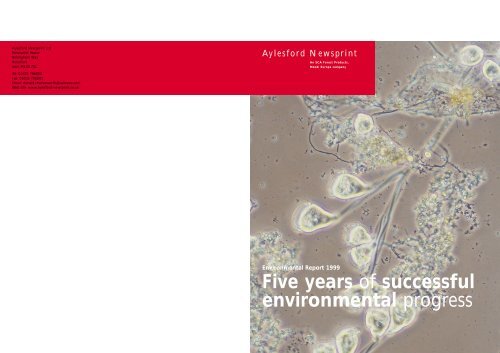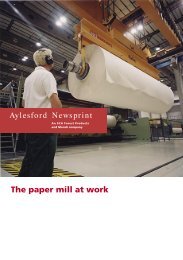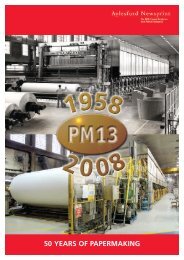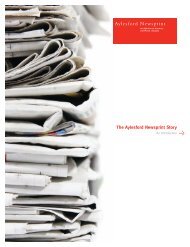water - Aylesford Newsprint
water - Aylesford Newsprint
water - Aylesford Newsprint
You also want an ePaper? Increase the reach of your titles
YUMPU automatically turns print PDFs into web optimized ePapers that Google loves.
AYLESFORD NEWSPRINT ENVIRONMENTAL REPORT 1999 11THE COMBINED HEAT ANDPOWER PLANT SUPPLIESAYLESFORD NEWSPRINT WITHSTEAM AND POWER.IPPC and thepaper industry trialIntegrated Pollution Prevention and Control (IPPC) is aninitiative by the European Union to improve environmentalprotection.The legislation is a development of the current Integrated Pollution Control (IPC)and develops a more holistic approach to environmental protection.The IPPC directive 96/61/EC defines the basic requirement to adopt “Best AvailableTechniques (BAT)”. The directive includes measures for reducing process waste;preventing pollution of <strong>water</strong>, air and soil; increasing energy efficiency; identificationand management of resources use and fugitive emissions (heat, noise and vibration).The EU Commission adopted the directive in September 1996 and member stateswere required to incorporate it into national legislation before October 1999.The Environment Agency have conducted trials during 1999 in various sectors ofUK industry. <strong>Aylesford</strong> <strong>Newsprint</strong> has participated in a field trial on behalf of thepaper and pulp industry reviewing draft IPPC guidance documentation andcompleting a proforma permit application.The trial was a partnership between the Environment Agency, the UK regulatorand the paper industry, providing the Company with an invaluable insight into theAgency’s planning for IPPC and providing the Agency with an opportunity tounderstand the costs and implications which IPPC would place on industry.
12 AYLESFORD NEWSPRINT ENVIRONMENTAL REPORT 1999AYLESFORD NEWSPRINT ENVIRONMENTAL REPORT 1999 13More emphasis onprevention asenvironmental regulationmoves to IPPCAYLESFORD NEWSPRINT’SWATER TREATMENT PLANTWITH THE PM14 MACHINEHOUSE IN THE BACKGROUND.An explanation by Dr. Johnson of the Environment Agency ofthe impact of the new regulation, with particular reference tothe paper industry.The passing of the Pollution Prevention and Control Act in July 1999 has paved theway for the introduction of the EU Directive on Integrated Pollution Prevention andControl (IPPC) as the prime legislation controlling pollution of the Environment inEngland and Wales. The current legislation of Integrated Pollution Control (IPC) underthe 1990 Environmental Protection Act will cease when the phased transfer ofregulation to IPPC is completed in 2007.The Regulations of the new Act are expected to set a timetable for the transfer ofindustrial sectors into IPPC with the Pulp & Paper Industry being one of the first. TheUK Government is keen that the IPPC application process is made relatively simplewith clear standards that represent the Best Available Techniques (BAT) for the controlof polluting emissions and this is to be achieved by clear guidelines and standardapplication forms. The Environment Agency’s reasoned decision on the application isto be made available as a public document and together, the application, the permitand the decision document are intended to provide a clear account of the regulatorycontrol of the applicant.During 1999 a series of IPPC application and permitting trials covering a wide rangeof industry sectors were conducted to test and develop the procedure. Both Industryand the Agency benefited from this process and were able to consider the technicaland resource implications and requirements. <strong>Aylesford</strong> <strong>Newsprint</strong> agreed to take thelead for the paper industry’s trial, which makes a second regulatory first, as they werealso the first IPC authorised process in the industry. The Agency adopted a teamapproach to their IPPC duties with experts in functions such as waste, <strong>water</strong> qualityand land contamination. The IPC site inspector who has long term knowledge of the<strong>Aylesford</strong> site and process led the Agency team. <strong>Aylesford</strong> <strong>Newsprint</strong> also found theteam approach essential to the application process with members representing thewhole range of activities involved in paper making.Considerations within IPPCApplication of the regulations evolved from the Paper Making Process and EnergyGeneration, to the inclusion of the adjoining SCA Packaging and Kimberly-Clarkbusinesses because of the link of the CHP operation. Energy efficiency also became amajor consideration with Sankey Energy Flow diagrams being used to demonstratethe flow of energy and the energy losses around the site. Another new aspect ofIPPC required that accidents with environmental consequences should be prevented.This meant that consideration had to be given to a series of “what if” questions inorder to avoid a risk of significant pollution. Loss of power on the Effluent TreatmentPlant was one possibility considered.Much of the Agency’s original application format was rewritten as a result ofextensive input by the Company’s team on the technical aspects of the paper makingprocess. The IPPC application package for the paper industry is now approaching itsfinal format as a direct result of the efforts of both teams and the trial hassignificantly helped in the development and understanding of the implications ofintroducing IPPC into industry generally.The Environment Agency has acknowledged the contribution of <strong>Aylesford</strong> <strong>Newsprint</strong>.DR. JOHNSON,ENVIRONMENT AGENCY
14 AYLESFORD NEWSPRINT ENVIRONMENTAL REPORT 1999AYLESFORD NEWSPRINT ENVIRONMENTAL REPORT 1999 15Emissions to <strong>water</strong>Water is essential for paper making. It is used to assist in formingthe sheet of paper on the paper machine and acts as a medium oftransport during the pulp preparation process.The mill has progressively increased theamount of <strong>water</strong> recycled within the processand currently some 93% is being recycled priorto discharge to the River Medway.The process <strong>water</strong> is cleaned by passingthrough a <strong>water</strong> treatment plant consisting ofprimary (filtration) and secondary biological(aeration and clarification) treatment processes.The <strong>water</strong> is cooled prior to discharging to theRiver Medway. Tertiary treatment is availableon site.The Water Treatment Plant for used process<strong>water</strong> is an authorised process under IntegratedPollution Control (IPC). During 1999 therewere no reported incidents or unauthoriseddischarges from the Effluent Treatment Plant.The quality of the <strong>water</strong> discharged during1999 was well within the prescribed limits.In 1999 we discharged 4.6 million m 3 of usedprocess <strong>water</strong> into the River Medway.On the 23rd July 1999, paper fibre escapedthrough surface drains and by way of aSouthern Water drainage system to the RiverMedway. Full protection of the discharge pointhad been provided and was activated. However,the Southern Water equipment was found notto have been operational. There was nopermanent harm to the environment and actionshave been implemented to avoid re-occurrence.Suspended SolidsSuspended Solids are found in the mill’s <strong>water</strong>discharge to the River Medway. They are verysmall cellulose fibres and “fillers” such as chalkand clay which are found in the raw materialand used in paper manufacturing to improvethe opacity of the finished paper. They are nontoxic but can create a fine silt in <strong>water</strong>ways.An amount of £120,000 has been invested inequipment and process improvements duringthe past five years. The year 1999 has seen anincrease in suspended solids emissionsdischarged per tonne of newsprint producedfor the first time in five years and we areinvestigating the reasons. The consent limit fordischarge is 60 mg/l and the Company hasaveraged 18.6 mg/l during 1999.Biological Oxygen Demand (BOD)The presence of BOD in <strong>water</strong> can bemeasured as the requirement for dissolvedoxygen arising from the microbiological(aerobic) breakdown of the material. Thereforethe BOD of a material gives a measure of thepotential for organic material to removeoxygen from <strong>water</strong>. Depletion of oxygen in ariver or stream deprives the natural habitat ofthe oxygen necessary for fish to survive.The consent limit for discharge is 1 tonne/dayand the mill has continued at 0.1 tonnes/daydischarge throughout 1999.Chemical Oxygen Demand (COD)Like BOD, COD is a measure of the potentialimpact of the organic content of used process<strong>water</strong>. We have completed two projects whichhave indicated that lignin and lignin typematerials are the main source of COD.Lignin is part of the natural building block oftrees and is retained in some pulps. 1999 is thethird consecutive year to achieve a reduction inthe discharge of COD per tonne of newsprintproduced.Pentachlorophenol (PCP)PCP is used as a wood preservative and apesticide. The material enters ourmanufacturing process through the mill’s rawmaterials - recovered newspapers and magazines- and is believed to originate from forestmanagement practices.PCP is a prescribed substance and is present inextremely low levels, well below the reportinglevels of 2,434 ng/litre and has been decreasingyear by year. Currently emissions are less than3% of the prescribed limit.Hexachlorocyclohexanes (HCH)HCH is frequently found in insecticides andpharmaceuticals entering the mill through therecovered paper and the <strong>water</strong> supply. Dailyemissions of HCH averaged below 25 ng/litrebeing less than 25% of the prescribed limit of100 ng/litre.TemperatureA limit on discharged waste <strong>water</strong> temperatureis important because an increase in <strong>water</strong>temperature would increase the respiratory rateof organisms, such as fish, and also reduce theoxygen content of the <strong>water</strong>. The mill waste<strong>water</strong> is typically in the range of 38° - 43°C.We operate two cooling towers to meet thedischarge limit of 30°C and a number ofprojects have focussed on optimising theoperational capabilities on the cooling process.There have been no breaches of the limitduring 1999.Inventory of sources and releasesThe mill monitors its various sources of <strong>water</strong>for potential environmental contaminants.There are eight abstraction sources available tothe mill for process <strong>water</strong>. Increased monitoringof the <strong>water</strong> discharge point had also beenimplemented. This has enabled the mill toestablish that the larger part of certain substancesdischarged to the River Medway are receivedin the <strong>water</strong> from abstraction sources. Suchmaterials include pesticides, herbicides, etc.We have reported the findings of ourmonitoring in accordance with the Inventoryof Sources and Releases procedures recentlyintroduced by the Environment Agency.ANNUAL EMISSIONSTO WATERSUSPENDEDSOLIDS97 kgs93 kgs77 kgs72 kgs86 kgs95 96 97 98 99‘000 KGS PER ANNUMANNUAL EMISSIONSTO WATERBOD60 kgs39 kgs42 kgs33 kgs37 kgs95 96 97 98 99‘000 KGS PER ANNUMANNUAL EMISSIONSTO WATERCOD886 kgs845 kgs964 kgs985 kgs986 kgs95 96 97 98 99‘000 KGS PER ANNUM
24 AYLESFORD NEWSPRINT ENVIRONMENTAL REPORT 1999Verification statementTo the Directors of <strong>Aylesford</strong> <strong>Newsprint</strong>LimitedThe <strong>Aylesford</strong> <strong>Newsprint</strong> EnvironmentalReport 1999 (“the Report”), covers <strong>Aylesford</strong><strong>Newsprint</strong>’s operations in Kent. The Report isthe responsibility of, and has been approved by,the Directors. The information contained inthe Report has been subject to an environmentalreview, guided by risk and materiality, carriedout by Price<strong>water</strong>houseCoopers.The objectives of the review were to:(a) assess the scope, content and format ofthe Report, confirming that the materialenvironmental aspects of <strong>Aylesford</strong><strong>Newsprint</strong>’s operations are fairly addressedand presented in the Report;(b) assess the reliability of reporting systemsand data relating to emissions to <strong>water</strong>, airand land, and natural resource use includingenergy and <strong>water</strong> supply, included in pages14 to 20 of the Report.Basis of opinionIn respect of (a), our work consisted ofmeetings with management responsible forenvironmental matters, site visits, examinationof documentation on current environmentalpolicies, practices and performance and limiteddesktop review of external environmentalissues affecting <strong>Aylesford</strong> <strong>Newsprint</strong>.In respect of (b), our work consisted of areview of the programme for data collection,analysis and reporting, and checking samplesof the data for each of the relevant areas ofenvironmental performance. The final Reportwas then examined to ensure that the contentwas consistent with the information gatheredduring our work.OpinionOn the basis of the information provided to usby <strong>Aylesford</strong> <strong>Newsprint</strong> during our review, inour opinion:• the systems used to produce the data in theReport in relation to emissions to <strong>water</strong>,air and land, and natural resource use, werereliable and the information included in theReport (on pages 14 to 20) is free frommaterial misstatement.CommentsDuring the verification process, we made anumber of observations, which have beenreported to management, on the content ofthe Report, the processes used to compilethe Report and on the future direction ofenvironmental management and reportingwithin <strong>Aylesford</strong> <strong>Newsprint</strong>. Our maincomments are that:• <strong>Aylesford</strong> <strong>Newsprint</strong>’s Management hasdemonstrated commitment to theEnvironment Policy. It continues to seekand invest in improvements to itsenvironmental performance, supported bya series of defined objectives and targets;• Whilst the Report does cover significantenvironmental issues, it could be improvedby reporting on carbon dioxide and methaneemissions, environmental expenditure andinvestment, special waste produced, andchemical use;• <strong>Aylesford</strong> <strong>Newsprint</strong> has a systematicframework for management and reportingof environmental performance. It isrecommended that the company continuesits programme of minimising data re-entryby directing all monitoring dataautomatically into its PQMS system;• <strong>Aylesford</strong> <strong>Newsprint</strong> recognises the role itcan play in the pursuit of sustainabledevelopment. In future, it could seek toreport on social and economic as well asenvironmental impacts. Further work isrequired to develop a framework that willallow the company to identify, monitor andreport on key performance parameters tosupport this objective.• material environmental aspects of <strong>Aylesford</strong><strong>Newsprint</strong>’s operations are fairly addressedand presented in the Report;





